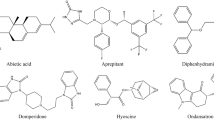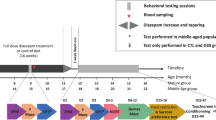Abstract
The highly potent and selective 5-HT6 receptor antagonist SB-271046 [5-chloro-N-(4-methoxy-3-piperazin-1-yl-phenyl)-3-methyl-2-benzothiophenesulfonamide] has previously been demonstrated to improve retention significantly in a spatial water maze paradigm in adult rats. However, SB-271046 did not have any effect on task acquisition. As these apparently contradictory findings may be reconciled by a prime influence of SB-271046 on memory consolidation, the ability of this compound to reverse the discrete temporal action of a cholinergic antagonist in the 6-h period following passive avoidance training was investigated. SB-271046, given orally, by gavage, 30 min prior to training Wistar rats in a step-through, light–dark passive avoidance task, was found to reverse significantly the amnesia produced by administering scopolamine (0.8 mg/kg, intraperitoneal) in the 6-h post-training period. The effect was dose-dependent over a range of 3–20 mg/kg. Further, we investigated the cognition-enhancing effects of chronic SB-271046 administration (10 or 20 mg/kg/day; 40 days) on the acquisition and consolidation of a water maze spatial learning task in a population of 20-month-old Wistar rats with age-related learning deficits. Drug treatment progressively and significantly decreased platform swim angle and escape latencies over the five sequential trials on four consecutive daily sessions compared to vehicle-treated controls. SB-271046 also improved task recall as measured by significant increases in the searching of the target quadrant on post-training days 1 and 3, when the animals would have been substantially drug-free. This significant improvement of task recall suggests SB-271046, in addition to inducing symptomatic cognition-enhancing actions, also attenuates age-related decline in neural function.
Similar content being viewed by others
Log in or create a free account to read this content
Gain free access to this article, as well as selected content from this journal and more on nature.com
or
References
Bartus RT, Dean RL, Beer B, Lippa AS (1982). The cholinergic hypothesis of geriatric memory dysfunction. Science 217: 408–417.
Bentley JC, Bourson A, Boess FG, Fone KFC, Marsden CS, Petit N et al (1999). Investigation of stretching behaviour induced by the selective 5-HT6 receptor antagonist, Ro-04-6790, in rats. Br J Pharmacol 126: 1537–1542.
Bliss TVP, Collingridge GL (1993). A synaptic model of memory: long-term potentiation in the hippocampus. Nature 361: 31–39.
Bromidge SM, Brown AM, Clarke SE, Dodgson K, Gager T, Grassam HL et al (1999). 5-Chloro-N-(4-methoxy-3-piperazin-1-yl- phenyl)-3-methyl-2-benzothiophenesulfon- amide (SB-271046): a potent, selective, and orally bioavailable 5-HT6 receptor antagonist. J Med Chem 42: 202–205.
Bromidge SM, Clarke SE, Gager T, Griffith K, Jeffrey P, Jennings AJ et al (2001). Phenyl benzenesulfonamides are novel and selective 5-HT6 antagonists: Identification of N-(2,5-dibromo-3-fluorophenyl)-4-methoxy-3-piperazin-1-ylbenzenesulfonamide (SB-357134). Bioorg Med Chem Lett 11: 55–58.
Bös M, Sleight A, Godel T, Martin JR, Riemer C, Stadler H (2001). 5-HT6 receptor antagonists: lead opptimisation and biological evaluation of N-aryl and N-heteroaryl 4-amino-benzene sulfonamides. Eur J Med Chem 36: 165–178.
Bourson A, Boess FG, Bös M, Sleight AJ (1998). Involvement of 5-HT6 receptors in nigro-striatal function in rodents. Br J Pharmacol 125: 1562–1566.
Bourson A, Borroni E, Austin RH, Monsma Jr F, Sleight AJ (1995). Determination of the role of the 5-ht6 receptor in the rat brain: a study using antisense oligonucleotides. J Pharmacol Exp Ther 274: 173–180.
Coyle JT, Price DL, DeLong MR (1983). Alzheimer's disease: a disorder of cortical cholinergic innervation. Science 219: 1184–1190.
Dawson L, Nguyen HQ, Li P (2000). In vivo effects of the 5HT6 receptor antagonist SB-270146 on striatal and frontal cortex extracellular concentrations of noradrenaline, dopamine, 5-HT, glutamate and aspartate. Br J Pharmacol 130: 23–26.
Dawson L, Nguyen HQ, Li P (2001). The 5HT6 receptor antagonist SB-271046 selectively enhances excitatory neurotransmission in the rat frontal cortex and hippocampus. Neuropsychopharmacology 25: 662–668.
Doyle E, Regan CM (1993). Cholinergic and dopaminergic agents which inhibit a passive avoidance response attenuate the paradigm-specific increases in NCAM sialylation state. J Neural Transm 92: 33–49.
Fone CF (2000). The 5-ht6 receptor: Potential CNS functions. Br J Pharmacol 131: 238P.
Fox GB, O'Connell AW, Murphy KJ, Regan CM (1995). Memory consolidation induces a transient and time-dependent increase in the frequency of NCAM-polysialylated cells in the adult rat hippocampus. J Neurochem 65: 2796–2799.
Gage FH, Dunnett SB, Bjorklund A (1984). Spatial learning and motor deficits in aged rats. Neurobiol Aging 5: 43–48.
Gallagher M, Pelleymounter MA (1988). Spatial learning deficits in old rats: a model for memory decline in the aged. Neurobiol Aging 9: 549–556.
Gérard C, Martres M-P, Lefévre K, Miquel M-C, Vergé D, Lanfumey L et al (1997). Immuno-localization of serotonin 5HT6 receptor-like material in the rat central nervous system. Brain Res 746: 207–219.
Hamon M, Doucet E, Lefévre K, Miquel M-C, Lanfumey L, Insausti R et al (1999). Antibodies and antisense oligonucleotide for probing the distribution and putative functions of central 5-HT6 receptors. Neuropsychopharmacology 21: 68S–76S.
Hirst WD, Minton JAL, Bromidge SM, Moss SF, Latter AJ, Riley G et al (2000). Characterization of [125I]-SB-258585 binding to human recombinant and native 5-HT6 receptors in rat, pig and human brain tissue. Br J Pharmacol 130: 1597–1605.
Meneses A (1999). 5-HT system and cognition. Neurosci Biobehav Rev 23: 1111–1125.
Meneses A (2001). Effects of the 5-HT6 receptor antagonist Ro 04-6790 on learning consolidation. Behav Brain Res 118: 107–110.
Monsma FJ, Shen Y, Ward RP, Hamblin MW, Sibley DR (1993). Cloning and expression of a novel serotonin receptor with high affinity for tricyclic psychotrophic drugs. Mol Pharmacol 43: 320–327.
Murphy KJ, O'Connell AW, Regan CM (1996). Repetitive and transient increases in hippocampal neural cell adhesion molecule polysialylation state following multi-trial spatial training. J Neurochem 67: 1268–1274.
Perry K, Johnson M, Kerwin JM, Piggott MA, Court JA, Shaw PJ et al (1992). Convergent cholinergic activities in aging and Alzheimer's disease. Neurobiol Aging 13: 393–400.
Rapp PR, Rosenberg RA, Gallagher M (1987). An evaluation of spatial information processing in aged rats. Behav Neurosci 101: 3–12.
Reavill C, Rogers DC (2001). The therapeutic potential of 5HT6 receptor antagonists. Curr Opin Invest Drugs 2: 104–109.
Routledge C, Bromidge SM, Moss SF, Price GW, Hirst WD, Newman H et al (2000). Characterization of SB-271046: A potent, selective and orally active 5-HT6 receptor antagonist. Br J Pharmacol 130: 1606–1612.
Rogers DC, Hagan JJ (2001). 5-HT6 receptor antagonists enhance retention of a water maze task in the rat. Psychopharmacology 158: 114–119.
Ruat M, Traiffort E, Arrrang J-M, Tardivel-Lacombe J, Diaz J, Leurs R et al (1993). A novel serotonin (5-HT6) receptor: molecular cloning, localisation and stimulation of cAMP accumulation. Biochem Biophys Res Commun 193: 268–276.
Shirazi-Southall S, Rodriguez DE, Nomikos GG (2002). Effects of typical and atypical antipsychotics and receptor selective compounds on acetylcholine efflux in the hippocampus of the rat. Neuropsychopharmacology 26: 583–594.
Sleight A, Boess FG, Bös M, Levet-Trafit B, Riemer C, Bourson A (1998). Characterization of Ro 04-6790 and Ro 63-0563: potent and selective antagonists at human and rat 5-HT6 receptors. Br J Pharmacol 124: 556–562.
Stean TO, Hirst WD, Thomas DR, Price GW, Rogers DC, Riley G et al (2002). Pharmacological profile of SB-357134: A potent, selective, brain penetrant and orally active 5-HT6 receptor antagonist. Pharmacol Biochem Behav 71: 645–654.
van der Staay FJ, de Jonge M (1993). Effects of age on water escape behavior and on repeated acquisition in rats. Behav Neural Biol 60: 33–41.
Ward RP, Dorsa DM (1996). Colocalization of serotonin receptor subtypes 5-HT2A, 5-HT2C and 5-HT6 with neuropeptides in rat striatum. J Comp Neurol 370: 405–414.
Whitehouse PJ, Price DL, Struble RG, Clark A, Coyle JT, De Long MR (1982). Alzheimer's disease, and senile dementia: loss of neurons in the basal forebrain. Science 215: 1237–1240.
Woolley ML, Bentley JC, Sleight AJ, Marsden CA, Fone KCF (2001). A role for 5-HT6 receptors in retention of spatial learning in the Morris water maze. Neuropharmacology 41: 210–219.
Acknowledgements
This work was supported by a research grant from GlaxoSmithKline.
Author information
Authors and Affiliations
Corresponding author
Rights and permissions
About this article
Cite this article
Foley, A., Murphy, K., Hirst, W. et al. The 5-HT6 Receptor Antagonist SB-271046 Reverses Scopolamine-Disrupted Consolidation of a Passive Avoidance Task and Ameliorates Spatial Task Deficits in Aged Rats. Neuropsychopharmacol 29, 93–100 (2004). https://doi.org/10.1038/sj.npp.1300332
Received:
Revised:
Accepted:
Published:
Issue date:
DOI: https://doi.org/10.1038/sj.npp.1300332
Keywords
This article is cited by
-
Spontaneous head twitches in aged rats: behavioral and molecular study
Psychopharmacology (2022)
-
5-Hydroxytryptamine receptor 6 antagonist, SB258585 exerts neuroprotection in a rat model of Streptozotocin-induced Alzheimer’s disease
Metabolic Brain Disease (2018)
-
Serotonin 5-HT6 Receptor Antagonists in Alzheimer’s Disease: Therapeutic Rationale and Current Development Status
CNS Drugs (2017)
-
The role of serotonin in memory: interactions with neurotransmitters and downstream signaling
Experimental Brain Research (2014)
-
Human fear reconsolidation and allelic differences in serotonergic and dopaminergic genes
Translational Psychiatry (2012)



